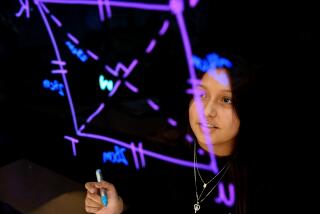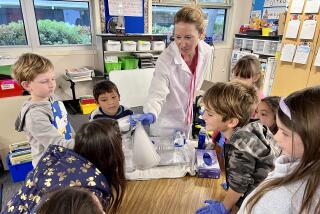The Education Games : Students Watch Course Work Come Alive at Simi Valley âOlympiadâ
Simi Valley sixth-grader Courtney Spencer cocked her arm and let fly with a sleek white paper airplane that arced through the air, leveled out and slid through a hoop erected several feet away.
As Courtney, 11, did a jig celebrating the feat, the adults standing nearby didnât reprimand her for the age-old classroom antic. Instead, they praised the Park View Elementary School student for her aerodynamic design.
âWhen you fold the creases really sharp and straight, it helps it fly better,â Courtney said, demonstrating the physics lesson she learned while experimenting with different wing designs to reduce resistance and ensure a steady flight.
More than 200 students from Simi Valley elementary schools watched their course work come alive Thursday during a Math-Science Olympiad at Royal High School.
At stations set up in the high schoolâs cafeteria, students worked to see how long they could make a paper bridge that could support the weight of a penny, made batteries from household objects, and raced snails while discussing the creaturesâ slimy habits.
In one corner, students tested homemade catapult gadgets to see how close they could land an object to the bullâs-eye.
âYou have to get the right angle to hit the target,â said Joanna Narbonne, 11, a sixth-grader at Garden Grove Elementary School.
At another end of the room, the children built skyscrapers from straws, the object being to make the structures as tall as possible without toppling them.
âThey learn to explore, they learn to try things and they learn that science can be fun,â said John Bickford, a science teacher at Sequoia Junior High School who spent the afternoon running the battery-making station.
As many as 16 students were allowed to participate in teams from each school. Teachers and principals at the schools chose the children who went, usually by reviewing grades or essays.
Although there was no competition, students often cheered and slapped high-fives when they finished a task. After completing each activity, they got stamps of achievement on their score cards.
Instead of winning, third-grade teacher Genny Pringle said, âthey work together cooperatively as a team and at the end, their reward is that structure theyâve built.â Still, some students couldnât resist seeking top status. Al Richmondâs sixth-grade class from Vista Elementary School screamed with delight when their tower of science books toppled from its tiny paper foundation when the 31st book was placed on top.
The previous record was 25 books, 11-year-old Megan Major explained excitedly. Then, revealing the groupâs secret, she said that narrow circular foundations can hold more weight. However, wider ones donât tip as easily, she said.
âYou have to make it somewhere in the middle,â Major said.
Nearby, students cheered their teamâs snail in a race that seemed to go nowhere. To prepare for questions that were asked during the race, the students studied the snailâs habitat and reproductive system, said Carol Brummett, a kindergarten and first-grade teacher at Big Springs Elementary.
âThey need moisture to slither,â said fifth-grader Dino Triolo, 10, in answer to a question about what snails need to survive.
Students who chose the seemingly fastest snails were disappointed when their racers slid around in circles instead of moving toward the finish line.
Parent Greta Vaught surveyed the scene with satisfaction. âTheyâre having fun, but theyâre learning at the same time,â she said.
More to Read
Get our high school sports newsletter
Prep Rally is devoted to the SoCal high school sports experience, bringing you scores, stories and a behind-the-scenes look at what makes prep sports so popular.
You may occasionally receive promotional content from the Los Angeles Times.






